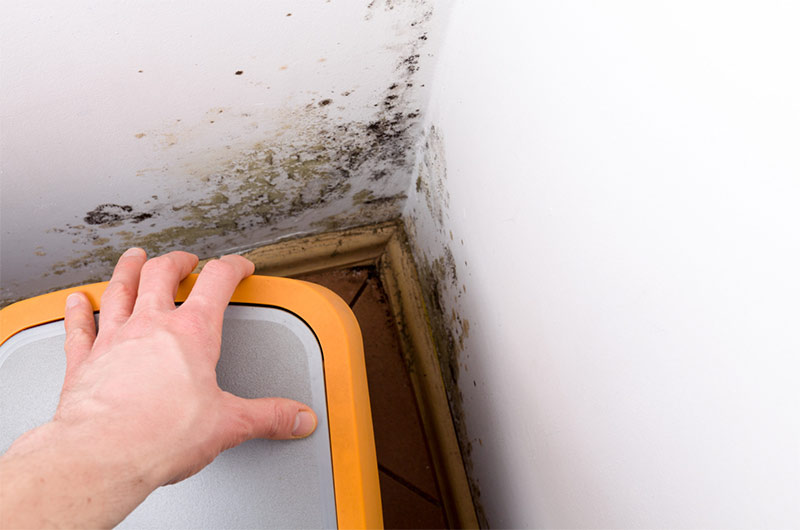Tackling Damp - The Benefits of Dehumidifiers in The Workplace
Damp is a common problem in the UK, whether at home or in the workplace. Combine the country's notoriously moist climate with ageing buildings and poor ventilation - and you get a recipe for damp-related disaster.
From mouldy walls and ceilings, peeling wallpaper to rotten floorboards, unstable stairs and that all-too-familiar musty smell, working environments with damp aren't just unpleasant for staff to operate within, they're potentially very harmful to your health!
Fortunately, there are several steps one can take to combat damp. In this article, we're going to explore how a handy humidifier, can help make damp one less debilitating dilemma to deal with!

What is damp?
There are three main types of damp: condensation damp, rising damp and penetrating damp. Condensation is the most common form of damp, caused when the air outside is colder than the air inside. This creates droplets of water that accumulate on cold surfaces, such as windows and walls.
Rising damp typically occurs in older buildings and enters the home from the ground. Signs of rising damp include stained plaster, peeling wallpaper along with rotting skirting boards and floors. Penetration damp is caused by water that enters the building from outside, through the ceiling, roof, and walls. This is usually due to common structural damage, such as loose tiles, overflowing gutters, leaking roofs, and pipes.
And where there's damp, there's usually mould. Mould is a type of fungus that is present everywhere. Damp areas, or where water build-up regularly occurs, are susceptible to mould growth. Mould spores can quickly grow when favourable conditions exist. If the air is humid, there is an increased chance of mould developing and spreading rapidly.
The health effects of damp
According to the NHS, damp and mould can trigger serious health problems such as allergies, infections and even toxic reactions
When moulds are disturbed, mould particles (spores and other debris), and volatile chemicals are released into the air and can be inhaled into the lungs and sinuses. Coming into contact with damp and moulds can be very harmful to people with normal healthy immune systems and even more dangerous to those with compromised immune systems.
Common health issues arising from exposure to mould caused by damp are those that affect the respiratory system. This isn't just because of the moisture in the air but also the microscopic bacteria and fungi that thrive in this type of environment, either floating around in the air or landing on moist surfaces. These issues include cold-like and allergy symptoms such as nasal stuffiness, eye irritation, throat irritation, wheezing, and coughing. More recently, the National Library of Medicine reports that damp and possibly moulds can cause and aggravate asthma.
Other common respiratory ailments associated with household damp include bronchitis, pneumonia, breathing difficulties and chest pains. But it's not just respiratory issues that can occur because of damp problems. Other issues include exacerbating skin conditions such as eczema, as well as causing nausea and fever.
Workplace regulations regarding damp
All employers have a legal responsibility to ensure their workers' health and safety, including taking adequate measures to safeguard against the numerous damaging health effects of damp and mould. The Health and Safety at Work legislation protects workers against hazardous working conditions. If you notice any mould in the workplace or start experiencing health problems, you should immediately report the issue to your employer.
Companies can tackle damp by:
- Detecting and locating the source of the moisture problem
- Removing any known mould infestations
- Controlling excessive moisture through adequate ventilation and methods such as installing dehumidifiers
If you report mould in the workplace and no action is taken, you are within your rights to report your concerns to an enforcing authority, such as the Health and Safety Executive (HSE) or another authority.
Dehumidifiers to the rescue!
A dehumidifier is a popular method to reduce humidity in the workplace.
A dehumidifier works by:
- drawing in ambient indoor air
- separating the air from the water
- collecting the water into a tank
- releasing the processed air back into the room
Benefits of a dehumidifier in the workplace:
- A dehumidifier is a good indicator of how much humidity is accumulating. Since many models gather collected water inside a removable reservoir, you can note how fast it is filling up and whether you need to take more comprehensive measures to reduce the humidity in your workplace.
- They don't require refills or special maintenance besides emptying the water collection tank.
- Dehumidifiers begin to reduce the amount of water in the air as soon as they're switched on.
- Dehumidifiers remove excess moisture from the air helping to prevent the build-up of mould and mildew.
- No one enjoys feeling sticky, especially while trying to work. Workplaces with proper humidity levels are generally more comfortable, while indoor air quality is usually improved.
- Another benefit of a dehumidifier is that it may control energy costs by helping your air conditioner work more efficiently. Because a dehumidifier's job is to remove moisture from the air, your air conditioner won't have to work as hard to maintain a comfortable temperature, saving energy usage and wear and tear on your cooling equipment.
- Many dehumidifiers are portable and multi-functional units which consist of an air conditioner and dehumidifier. Mounting on castors allows you to conveniently move them to where they're required within the workplace.
So, there you have it, folks - hooray for dehumidifiers!

Author Bio - Debs
Digital marketer, social media, content writer, musician, sloth-lover, tea-drinker.





